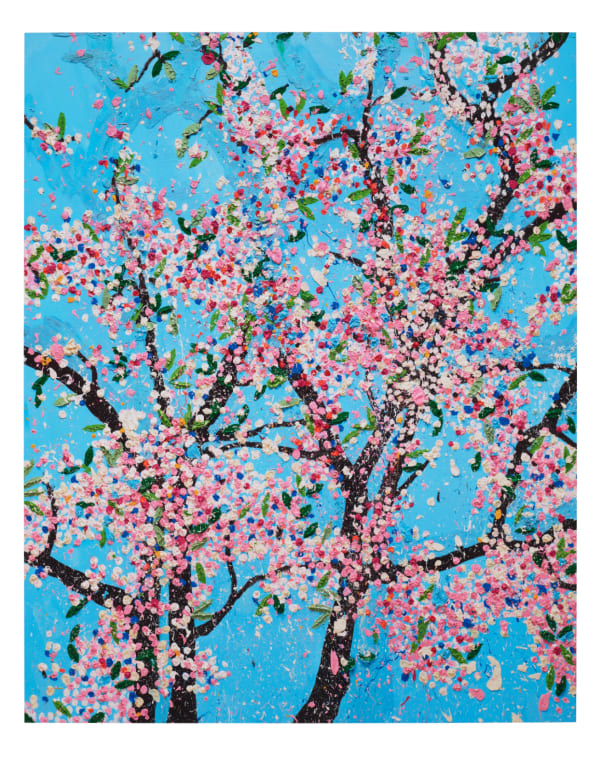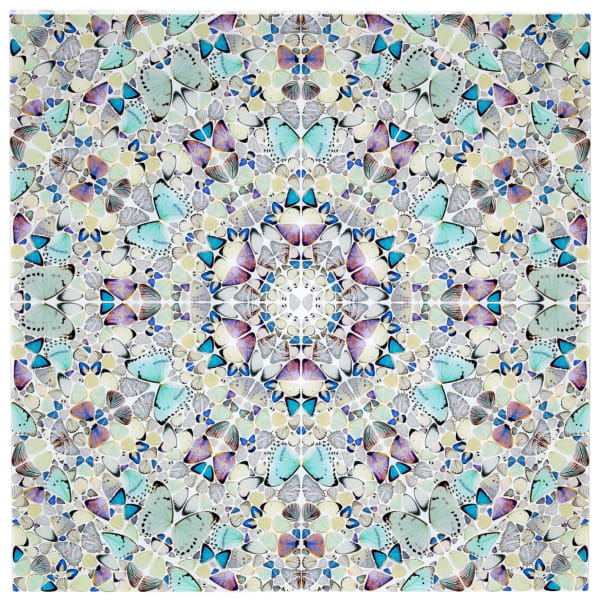Damien Hirst
"It’s amazing what you can do with an E in A-Level art, a twisted imagination and a chainsaw."
British artist, Damien Hirst, emerged onto the art scene in the late 1980s. His practice examines the complex relationships between mortality, religion and science, beauty and art. From suspending sharks in vast tanks of formaldehyde, to encrusting human skulls with diamonds, his works are both visceral and visually arresting, pushing the boundaries on what has come to define contemporary art culture.
Hirst’s artistic career started with his move to London in 1984, where he studied Fine Art at Goldsmith College. During his studies, Hirst orchestrated Freeze, an independent student exhibition, housed in London’s docklands. The show was visited by Charles Saatchi and would mark a defining moment for Hirst and the group of artists known as the Young British Artists. In 1991, Charles Saatchi offered to fund Hirst’s artistic productions, resulting in the first Young British Artists exhibition at the Saatchi Gallery. Entitled ‘The Physical Impossibility of Death in the Mind of Someone Living’, Hirst suspends a shark in formaldehyde. His ‘Natural History’ series exemplifies his fascination with art and science. Suspending nature in vitrines operates as both a barrier and a window to the viewer, aiming to throw fundamental light on the fragility of life .
Damien Hirst’s artistry extends beyond one medium. In his spin paintings, a machine centrifugally disperses paint over the canvas spontaneously. This stands in complete contrast to his spot series which is calculated and meticulous. In 2007, Hirst created his most provocative work to date, ‘For the Love of God’, a platinum cast of a human skull covered with pave set diamonds. The work acts as a traditional memento mori, using art to address the transience of human existence.
Since 1987, Hirst has had over 90 solo exhibition, he has been included in more than 300 group shows and now ventures outside the realms of art.
-
 H10 Empresses (Set of 5), 2022
H10 Empresses (Set of 5), 2022 -
 Nūr Jahān H10-2, 2022
Nūr Jahān H10-2, 2022 -
 Suiko H10-4, 2022
Suiko H10-4, 2022 -
 Courage (H9-2), 2021
Courage (H9-2), 2021 -
 Honesty (H9-5), 2021
Honesty (H9-5), 2021 -
 Justice (H9-1), 2021
Justice (H9-1), 2021 -
 Locked Up All Night, 2021
Locked Up All Night, 2021 -
 Mercy – H9-3 (The Virtues), 2021
Mercy – H9-3 (The Virtues), 2021 -
 Politeness (H9-4), 2021
Politeness (H9-4), 2021 -
 The Virtues, 2021
The Virtues, 2021 -
 You're Afraid (The Currency), 2021
You're Afraid (The Currency), 2021 -
 Butterfly Heart (Large), 2020£ 2,000.00
Butterfly Heart (Large), 2020£ 2,000.00 -
 H4-5 Nong Nooch (Veils), 2020
H4-5 Nong Nooch (Veils), 2020 -
 Keukenhof (H4-8), 2020
Keukenhof (H4-8), 2020 -
 The Elements: Air (H6-7), 2020
The Elements: Air (H6-7), 2020 -
 Beverley Hills (H5-2), 2018
Beverley Hills (H5-2), 2018 -
 Cafe Royal (H5-7), 2018
Cafe Royal (H5-7), 2018 -
 Savoy (H5-8), 2018
Savoy (H5-8), 2018 -
 THR-Ser, from 40 Woodcut Spots, 2012
THR-Ser, from 40 Woodcut Spots, 2012 -
 Benzyloxyurea from 40 Woodcut Spots, 2011
Benzyloxyurea from 40 Woodcut Spots, 2011 -
 Proctolin with Bronze Glitter, 2008
Proctolin with Bronze Glitter, 2008 -
 Ciclopirox Olamine, 2004
Ciclopirox Olamine, 2004 -
 Cinchonidine, 2004
Cinchonidine, 2004 -
 Cineole, 2004
Cineole, 2004
-

Let's Beat the Blues
Our favourite pieces of art to help raise our spirits this January 12 January 2023With the post-Christmas merriment and the back-to-office shake well underway, life can feel hard to navigate around. At this time of year, it’s easy to...Read more -

Frieze 2022
Our Top Picks 18 October 2022What did we find at Frieze 2022, here are our top picks for this year’s art fair. Blue-Chip Work Damien Hirst, Veil of Dreaming, 2017...Read more -

Frieze 2022
The Insider’s Guide To Frieze 11 October 2022As October approaches, the British art world goes into overdrive. Artists, gallerists and collectors descend on the city, attempting to keep up with a hectic...Read more



























